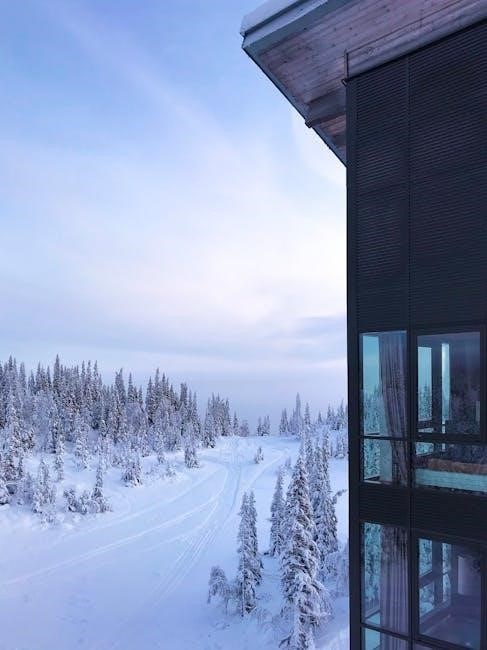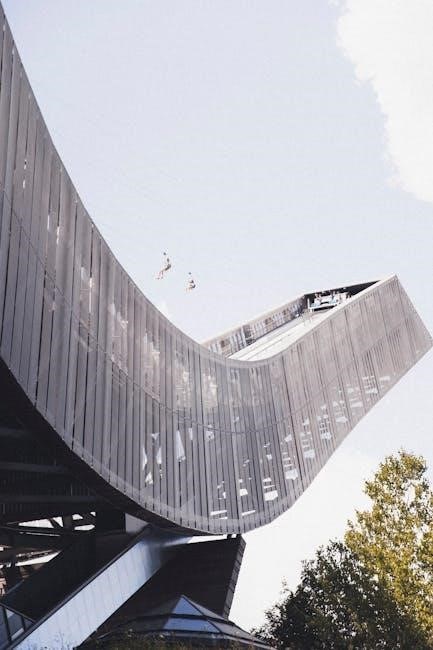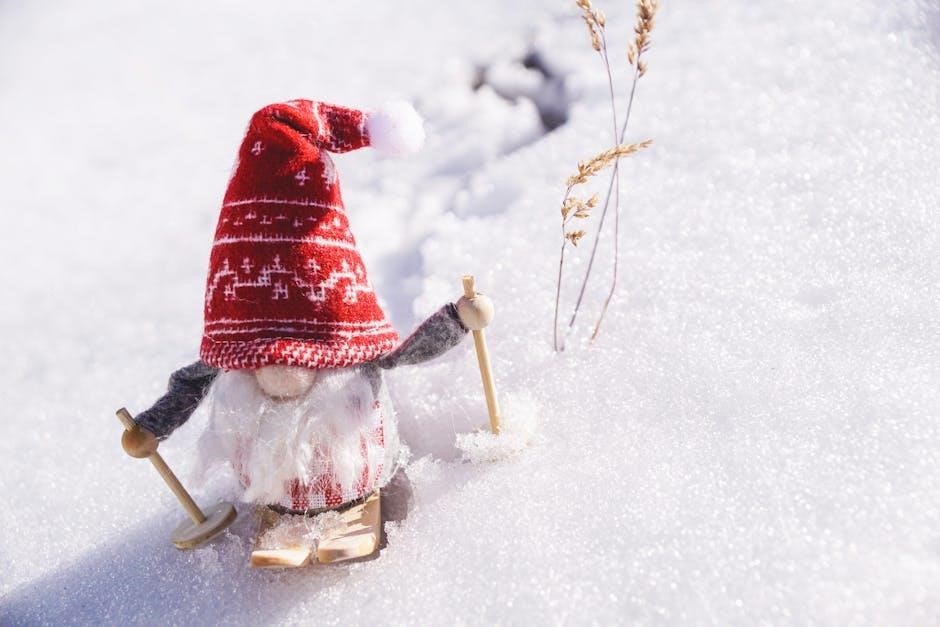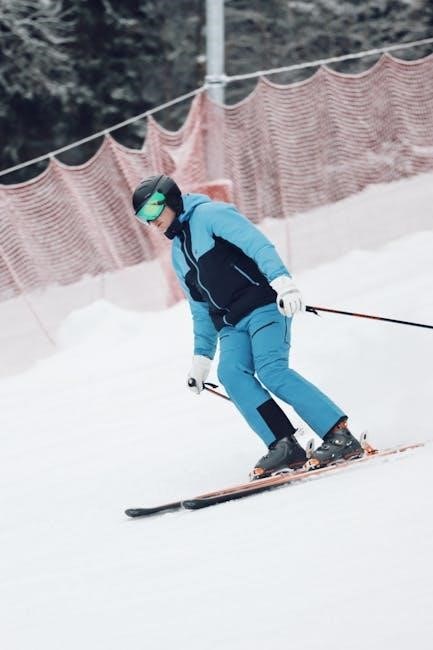nordic ski size guide

Finding the perfect Nordic ski size is crucial for an enjoyable experience. Height and weight are key factors, determining the ideal ski length. This guide helps you navigate the process, ensuring comfort and optimal performance on the snow.
Importance of Correct Ski Sizing
Selecting the correct Nordic ski size is paramount for maximizing performance, comfort, and control on the trails. The right size ensures efficient gliding and stability, enhancing the overall skiing experience. A properly sized ski allows for better weight distribution, enabling skiers to maintain balance and execute techniques effectively.
Conversely, skis that are too long or too short can lead to difficulties in maneuvering, reduced speed, and increased fatigue. Ill-fitting skis can also compromise safety, making it harder to control descents and navigate challenging terrain. Therefore, taking the time to determine the appropriate ski size is an investment in a more enjoyable and successful Nordic skiing adventure. Remember, proper sizing contributes to both performance and safety on the snow.
Factors Influencing Ski Size
Determining the appropriate Nordic ski size involves considering several key factors beyond just height. Skier weight plays a crucial role, influencing the ski’s flex and load-bearing capacity. Skiing style, whether classic, skate, or touring, dictates the ideal ski length and characteristics. Classic skis typically require a longer length compared to skate skis for optimal glide and kick.
Skill level also affects ski size selection; beginners may benefit from shorter skis for easier maneuverability, while advanced skiers might prefer longer skis for increased speed and stability. Understanding these factors ensures a tailored fit, enhancing performance and enjoyment on the trails. Ultimately, a holistic assessment of these elements leads to selecting the perfect ski size.

Skier Height
Skier height is a primary determinant when selecting Nordic ski size. Generally, taller individuals require longer skis to maintain balance and stability. Height provides a baseline for ski length, influencing the overall performance and control.
Reference charts often use height as the initial point, allowing for a range of ski lengths based on other factors. It’s crucial to accurately measure height to ensure the selected ski falls within the appropriate range. This measurement serves as a starting point, further refined by considering weight, skiing style, and skill level. Therefore, precise height measurement is an essential first step in the ski sizing process, ensuring a comfortable and efficient skiing experience.
Skier Weight
Skier weight is a critical factor in determining the appropriate Nordic ski size and flex. Weight influences how the ski interacts with the snow, affecting glide and control. A heavier skier requires a stiffer ski to prevent it from sinking too deep, ensuring efficient energy transfer. Conversely, a lighter skier needs a more flexible ski to achieve proper compression and grip.
Weight, in conjunction with height, refines the ski length selection process. Charts often provide weight ranges for specific ski lengths, guiding skiers to the optimal size. Selecting a ski that aligns with weight ensures proper performance and prevents issues like poor glide or lack of control.
Skiing Style (Classic, Skate, Touring)
The type of Nordic skiing significantly impacts ski size selection. Classic skiing involves striding in groomed tracks, requiring longer skis for enhanced glide and stability. Skate skiing utilizes a skating motion on groomed surfaces, favoring shorter skis for maneuverability and quick turns. Touring skis, designed for off-track exploration, typically fall between classic and skate ski lengths.
Classic skis need to be longer to provide a sufficient kick zone for efficient propulsion. Skate skis are shorter to allow for agility and responsiveness. Touring skis vary in length depending on the terrain and intended use, balancing glide and control for varied snow conditions.
Skill Level
Your skiing proficiency plays a crucial role in determining the appropriate ski size. Beginners often benefit from shorter skis, as they are easier to control and maneuver. Shorter skis enhance stability and make turning less challenging, allowing new skiers to develop fundamental skills with greater confidence.
Intermediate skiers can gradually transition to slightly longer skis, providing a balance between control and glide; Advanced skiers often prefer longer skis, maximizing speed and efficiency on the snow. Longer skis offer increased stability at higher speeds and improved glide for experienced skiers seeking optimal performance.
Cross Country Ski Size Chart
To simplify the ski selection process, cross country ski size charts provide guidelines based on height and weight. These charts offer a starting point for determining the appropriate ski length for both adults and children. Consult the appropriate chart based on the skier’s age and measurements to find a suitable range of ski lengths.
These charts typically present a matrix of height and weight ranges, with corresponding recommended ski lengths. Remember that these charts offer a general recommendation, and individual preferences and skiing style may necessitate adjustments. Always consider other factors, like skill level, for the best fit.
Adult Ski Sizing Chart (Weight vs. Ski Length)
The adult ski sizing chart is based on weight. Weight is the dominant factor in determining the appropriate ski length for adults. The chart relates weight ranges to recommended ski lengths for classic, skate, and touring styles, allowing you to make an informed decision.
The adult ski sizing chart helps you choose skis that suit your weight. It’s important to find the range that aligns with your weight. With this information, you will have multiple skis to choose from. Using the chart, you should choose the ski that best suits your weight at the correct height.
Children’s Ski Sizing Chart (Height vs. Ski Length)
The children’s ski sizing chart primarily uses height. Height is a key determinant for children’s ski length due to their developing strength and coordination. The chart correlates height ranges with suitable ski lengths, ensuring that young skiers have appropriate equipment for their size.
Find your childs height on the below chart. If your childs height is between two of the listed heights, find their weight. In general shorter skis will be easier to maneuver while longer skis will be more stable. If your child is between sizes, choose the ski that fits your child’s weight and height.
Classic Ski Sizing
Classic ski sizing relies on height and weight. This ensures optimal grip and glide during classic cross-country skiing. The ideal classic ski should be approximately 10-30 cm above the skier’s height. This length allows for efficient striding and poling, which are essential for classic technique.
Weight is also crucial, influencing the ski’s flex. The ski needs to compress properly for the wax pocket to engage, providing grip on the snow; Using the chart, you should choose the ski that best suits your weight at the correct height.
Ideal Length for Classic Skis
Determining the ideal length for classic skis is crucial for optimal performance and enjoyment. The general rule is to select skis that are 10 to 30 cm longer than the skier’s height. This additional length provides the necessary surface area for efficient gliding and striding on groomed tracks.
The skier’s weight also plays a significant role in determining the appropriate ski length. A heavier skier will require a longer ski to ensure proper weight distribution and maintain optimal glide. Conversely, a lighter skier may prefer a shorter ski for increased maneuverability and control.
Skate Ski Sizing
Skate ski sizing is critical for optimizing performance in this dynamic Nordic discipline. Unlike classic skis, skate skis are typically shorter, prioritizing maneuverability and efficient energy transfer. The ideal length generally ranges from the skier’s height to 15 cm above their height. This allows for quick changes in direction and powerful strides.
Skier weight is crucial for determining the specific length within this range. Heavier skiers benefit from slightly longer skis, providing increased stability and support. Lighter skiers often prefer shorter skis for enhanced agility and responsiveness. Skill level also plays a role; experienced skaters may opt for longer skis.
Ideal Length for Skate Skis
Determining the ideal length for skate skis involves considering several factors, primarily the skier’s height and weight. As a general guideline, skate skis should be approximately the same height as the skier or up to 15 cm longer. This range allows for efficient gliding and powerful propulsion, essential for the skate skiing technique.
However, weight plays a significant role in fine-tuning the selection. Heavier skiers require longer skis to provide adequate support and stability, while lighter skiers may prefer shorter skis for increased maneuverability and control. Skill level also influences the choice, with advanced skiers often opting for longer skis to maximize glide and speed on open terrain.

Nordic Ski Boot Sizing
Selecting the right size Nordic ski boots is vital for comfort, performance, and preventing injuries. Unlike alpine boots, Nordic ski boots allow the heel to lift, enabling the cross-country skiing motion. Accurate sizing ensures a snug yet comfortable fit, maximizing control and minimizing blisters. Start by referencing a cross country boot size chart, comparing your standard shoe size to Nordic-specific measurements.
Consider that Nordic boots often use European sizing, so conversion is necessary. When trying on boots, wear appropriate ski socks and ensure your toes have some wiggle room. A secure heel fit is crucial to prevent slippage and maintain efficient power transfer. Remember, proper boot fit is paramount for an enjoyable skiing experience.

Boot Fit and Performance
The fit of your Nordic ski boots significantly impacts your skiing performance and overall comfort. A properly fitted boot enhances control, responsiveness, and power transfer, allowing for more efficient strides. A boot that’s too large can lead to slippage, blisters, and reduced control, while a boot that’s too small can cause discomfort and restrict circulation.
When assessing boot fit, focus on the heel hold and the amount of room in the toe box. The heel should be snug and secure, preventing any unwanted movement during skiing. The toes should have enough space to wiggle, ensuring proper circulation and warmth. Consider the stiffness of the boot, which should align with your skiing style and skill level. Ultimately, the correct boot fit is a balance of comfort and performance.
Cross Country Boot Size Chart

Determining your correct cross country boot size is essential for comfort and performance. Start by measuring your foot length accurately, wearing socks similar to those you’ll use for skiing. Compare your measurements to a cross country boot size chart, keeping in mind that sizing can vary slightly between brands.
Generally, cross country ski boots fit similarly to standard athletic shoes; You might consider sizing down for a tighter, more performance-oriented fit, but avoid sizing up, as excessive room can lead to warmth issues and blisters. Refer to a specific brand’s size chart whenever possible, and consider trying on boots in person to ensure the best possible fit. Euro and UK size conversions are also available on most charts for comparison. Remember, a well-fitted boot is crucial for an enjoyable cross-country skiing experience.
Ski Pole Sizing
Selecting the correct ski pole size is crucial for maintaining balance, power, and efficiency while cross-country skiing. Pole length is primarily determined by skier height and the specific skiing style, whether classic or skate.
For classic skiing, the general rule is to choose poles that reach approximately to your armpit or slightly below. For skate skiing, poles should be longer, typically reaching between your shoulder and chin. A helpful method is to multiply your height in inches by 0.83 for classic poles and 0.89 for skate poles.
Refer to a ski pole sizing chart that correlates skier height with recommended pole length for both classic and skate styles. When standing, the grip should be comfortably in your hand with your elbow bent at a 90-degree angle.
Skier Height to Pole Length Chart
A skier height to pole length chart is an invaluable tool for determining the appropriate pole size for cross-country skiing. These charts typically list skier heights in inches or centimeters alongside recommended pole lengths, also in inches or centimeters. Separate recommendations are provided for classic and skate skiing techniques due to the differing demands of each style.
To use the chart, find your height and then identify the corresponding pole length. For classic skiing, the pole should generally reach from the ground to somewhere between your armpit and shoulder. For skate skiing, the pole should extend higher, typically reaching between your shoulder and chin.
Always consider personal preference and terrain. If you’re between sizes, err towards the longer side for skate and shorter for classic.